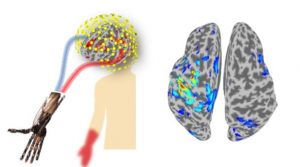CiNet Researchers have used AI methods to identify the cause of chronic untreatable pain in patients with amputations and severe nerve damage, as well as a potential treatment which relies on engineering instead of drugs.
They have discovered that a ‘reorganisation’ of the wiring of the brain is the underlying cause of phantom limb pain, which occurs in the vast majority of individuals who have had limbs amputated, and a potential method of treating it which uses artificial intelligence techniques.

The researchers, led by a group from Osaka University in Japan in collaboration with the University of Cambridge, used a brain-machine interface to train a group of ten individuals to control a robotic arm with their brains. They found that if a patient tried to control the prosthetic by associating the movement with their missing arm, it increased their pain, but training them to associate the movement of the prosthetic with the unaffected hand decreased their pain.
Their results, reported in the journal Nature Communications,
demonstrate that in patients with chronic pain associated with amputation or nerve injury, there are ‘crossed wires’ in the part of the brain associated with sensation and movement, and that by mending that disruption, the pain can be treated. The findings could also be applied to those with other forms of chronic pain, including pain due to arthritis.
Read more on Livescience
Citation: Induced sensorimotor brain plasticity controls pain in phantom limb patients.
Takufumi Yanagisawa, Ryohei Fukuma, Ben Seymour, Koichi Hosomi, Haruhiko Kishima, Takeshi Shimizu, Hiroshi Yokoi, Masayuki Hirata, Toshiki Yoshimine, Yukiyasu Kamitani, Youichi Saitoh Nature Communications 7, Article number: 13209 (2016)
doi:10.1038/ncomms13209
URL: http://rdcu.be/l39w
